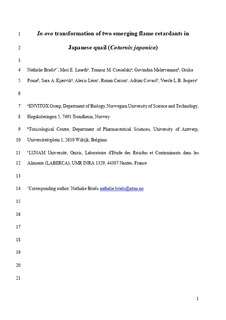| dc.contributor.author | Briels, Nathalie | |
| dc.contributor.author | Løseth, Mari Engvig | |
| dc.contributor.author | Ciesielski, Tomasz Maciej | |
| dc.contributor.author | Malarvannan, Govindan | |
| dc.contributor.author | Poma, Giulia | |
| dc.contributor.author | Kjærvik, Sara Alainezhad | |
| dc.contributor.author | Léon, Alexis | |
| dc.contributor.author | Cariou, Ronan | |
| dc.contributor.author | Covaci, Adrian | |
| dc.contributor.author | Jaspers, Veerle | |
| dc.date.accessioned | 2019-03-22T12:35:32Z | |
| dc.date.available | 2019-03-22T12:35:32Z | |
| dc.date.created | 2018-01-07T15:19:13Z | |
| dc.date.issued | 2018 | |
| dc.identifier.citation | Ecotoxicology and Environmental Safety. 2018, 149 51-57. | nb_NO |
| dc.identifier.issn | 0147-6513 | |
| dc.identifier.uri | http://hdl.handle.net/11250/2591315 | |
| dc.description.abstract | Tris(1,3-dichloro-2-propyl) phosphate (TDCIPP) and Dechlorane Plus (DP) are two chlorinated, alternative flame retardants that have been found in wild birds and bird eggs. Little is known about the fate and effect of these compounds in birds, especially during the vulnerable stages of embryonic development. To investigate the ability of birds to biotransform these compounds, an in ovo exposure experiment with Japanese quail eggs was performed. Quail eggs were injected in the yolk sac with 1000 ng/g egg of TDCIPP (2.3 nmol/g ww), DP (1.5 nmol/g ww) or a mixture of both and were then incubated at 37.5 °C for 17 days. To get a time-integrated understanding of the in ovo transformation of the compounds, one egg per treatment was removed from the incubator every day and analyzed for TDCIPP and its metabolite bis(1,3-dichloro-2-propyl) phosphate (BDCIPP) and/or for DP. By the end of the incubation period, TDCIPP was completely metabolized, while simultaneously BDCIPP was formed. The conversion of the parent compound into the metabolite did not occur proportionally and the concentration of BDCIPP showed a tendency to decrease when TDCIPP became depleted, both indicating that BDCIPP was further transformed into compounds not targeted for analysis. Further untargeted investigations did not show the presence of other metabolites, possibly due to the volatility of the metabolites. On the other hand, the DP concentration did not decrease during egg incubation. This study indicates that within the incubation period, avian embryos are able to biotransform TDCIPP, but not DP. | nb_NO |
| dc.language.iso | eng | nb_NO |
| dc.publisher | Elsevier | nb_NO |
| dc.rights | Attribution-NonCommercial-NoDerivatives 4.0 Internasjonal | * |
| dc.rights.uri | http://creativecommons.org/licenses/by-nc-nd/4.0/deed.no | * |
| dc.title | In ovo transformation of two emerging flame retardants in Japanese quail (Coturnix japonica) | nb_NO |
| dc.type | Journal article | nb_NO |
| dc.type | Peer reviewed | nb_NO |
| dc.description.version | acceptedVersion | nb_NO |
| dc.source.pagenumber | 51-57 | nb_NO |
| dc.source.volume | 149 | nb_NO |
| dc.source.journal | Ecotoxicology and Environmental Safety | nb_NO |
| dc.identifier.doi | 10.1016/j.ecoenv.2017.10.069 | |
| dc.identifier.cristin | 1537179 | |
| dc.relation.project | Norges forskningsråd: 230465 | nb_NO |
| dc.description.localcode | © 2018. This is the authors’ accepted and refereed manuscript to the article. Locked until 15.11.2019 due to copyright restrictions. This manuscript version is made available under the CC-BY-NC-ND 4.0 license http://creativecommons.org/licenses/by-nc-nd/4.0/ | nb_NO |
| cristin.unitcode | 194,66,10,0 | |
| cristin.unitname | Institutt for biologi | |
| cristin.ispublished | true | |
| cristin.fulltext | postprint | |
| cristin.qualitycode | 1 | |

